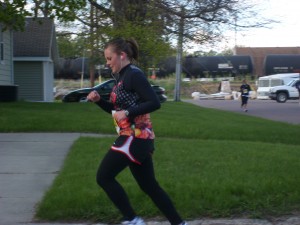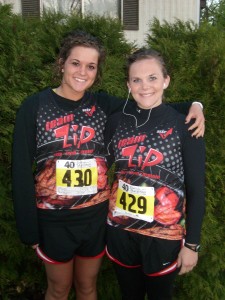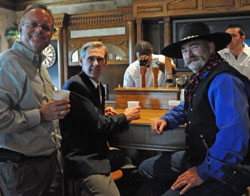 I missed the Association for Downloadable Media’s webcast titled, “The Podcast Consumer Revealed.” The session was conducted by Tom Webster, Edison Research. The audience for podcasting just keeps growing. The main reasons people watch or listen to podcasts is so they can do so whenever and wherever they want. Here are some key points from the session.
I missed the Association for Downloadable Media’s webcast titled, “The Podcast Consumer Revealed.” The session was conducted by Tom Webster, Edison Research. The audience for podcasting just keeps growing. The main reasons people watch or listen to podcasts is so they can do so whenever and wherever they want. Here are some key points from the session.
* 1 in 5 Americans (22%) have listened to a podcast.
* 59% men 41% women, 18-44 demo = 60% of podcast users.
* Most downloadable media is consumed via desktop, mobile growing.
* Podcast users are very active on social networks – mainly Myspace and Facebook
* 24% of podcast consumers feel “emotional connection” with their favorite podcasts.
* Podcast consumers are more receptive to advertisers heard in podcast vs heard via internet radio.
* Producers need to do a better job of selling the portable aspects.
If you’d like to know more then feel free to watch the recorded presentation here.
Running with Team ZIP
 A few months ago, I signed up for a half-marathon with my sister, Courtney. To boost our motivation, we joined Team ZIP (Zinc/Iron/ Protein), a group of runners who believe in the power of protein in the land of lean beef. We demonstrate that beef gives us the strength we need to cross the finish line by participating in running, cycling and triathlon events across the country. On May 16, just a week after my graduation from SDSU, Courtney and I ran our hearts out on behalf of America’s farmers and ranchers.
A few months ago, I signed up for a half-marathon with my sister, Courtney. To boost our motivation, we joined Team ZIP (Zinc/Iron/ Protein), a group of runners who believe in the power of protein in the land of lean beef. We demonstrate that beef gives us the strength we need to cross the finish line by participating in running, cycling and triathlon events across the country. On May 16, just a week after my graduation from SDSU, Courtney and I ran our hearts out on behalf of America’s farmers and ranchers.
 This was my first half marathon, and I was proud to hear my name called as I crossed the finish line, announcing that I was running in support of beef. My jersey proudly said, “Beef, it’s what’s for dinner,” and it earned me quite a few comments and cheers throughout the race. Although my muscles were sore from the intensity of the race, my heart was proud of myself for finishing the race within my goal time.
This was my first half marathon, and I was proud to hear my name called as I crossed the finish line, announcing that I was running in support of beef. My jersey proudly said, “Beef, it’s what’s for dinner,” and it earned me quite a few comments and cheers throughout the race. Although my muscles were sore from the intensity of the race, my heart was proud of myself for finishing the race within my goal time.
If you are a runner or are interested in promoting agriculture in unique ways such as this, I encourage you to check out Team ZIP. There is a great bunch of folks that are a part of that group, and they are not only dedicated to living healthy, but also in protecting the integrity of the agriculture industry. I’m so proud to be a part of this group!
BIVI Swine Division Picks Woodruff Sweitzer and True Media
 It looks like Woodruff Sweitzer and True Media have reason to celebrate this holiday weekend.
It looks like Woodruff Sweitzer and True Media have reason to celebrate this holiday weekend.
Boehringer Ingelheim Vetmedica, Inc., headquartered in St. Joseph, Mo., selected Woodruff Sweitzer to manage advertising, strategic consultation and brand development for their swine products division. True Media has been chosen to handle media planning and buying.
 Woodruff Sweitzer will partner with BIVI to develop strategic plans, advertising, sales materials and collateral for major swine vaccines (Ingelvac CircoFLEX®, Ingelvac MycoFLEX®, Ingelvac® PRRS and Enterisol® Ileitis). Beginning in July 2009, True Media will manage the media planning and buying, which is focused primarily on Web and professional trade publications.
Woodruff Sweitzer will partner with BIVI to develop strategic plans, advertising, sales materials and collateral for major swine vaccines (Ingelvac CircoFLEX®, Ingelvac MycoFLEX®, Ingelvac® PRRS and Enterisol® Ileitis). Beginning in July 2009, True Media will manage the media planning and buying, which is focused primarily on Web and professional trade publications.
Many Tanks Make A Good Beer
I promise you that this will be my last post of the week with Trent Loos in it. Why? Because it’s the end of the week and it’s all I’ve got. After I had my chance to interview Alltech Lexington Brewing Company Master Brewer Ken Lee, Trent and Sarah did a video interview with him in which I got to play a bit part. So we had fun while we learned and hopefully you will too.
Benefit Auction Information for Cattle Family
There is an Iowa family in need of your help. This family has strong ties to agriculture and the cattle business. This is a chance to reach out to help two little boys that were dealt a difficult hand of cards in life. I thought I would pass this along…
Bode and Brystol Druckenmiller of Indianola, Iowa are wonderful boys with loving, caring parents and for this they are certainly lucky. Luck doesn’t exactly come to mind when I think about these awesome little guys, however, and for good reason. Both are hemophiliacs with Factor 8 deficiencies and Brystol was also born with a complex heart defect requiring multiple additional cardiac surgeries. Each has has multiple recurrent hospitalizations over essentially their entire lives, yet today they are strong, bright young boys that I hope the cattle community will see fit to help.
The boys’ father Jeff Druckenmiller was raised in Fremont, OH while their mother was from the Fremont here in Iowa. Both were active in the cattle industry with Ashley showing many a champion across the state of Iowa. Today, Jeff works as a diesel mechanic when the boys are healthy enough to allow, Ashley works at a charity here in Indianola called Family Rewards, also working double shifts when she can at the local sportsbar Sports Page. I’ve seen many people labelled as “hero” over the last few years and would put Ashley up next to any of them. This is an excellent family and I hope you find a way to help. We would gladly accept donations of any kind. If you would like to help the Druckenmiller family, consider donating here.
If you have an item that you would like to donate to the auction, e-mail the information to jhrutkay@clubcalves.com and she will add the item. Anything you can do is appreciated more than you can imagine. Nothing feels better than helping those in need! Thanks to everyone who donates and bids! Auction will begin May 19 and conclude May 25 at 7 PM EST! Payment is due in full by May 30th unless other arrangements are agreed upon with Alan McDaniel.
Alltech Symposium Wrapup
 The Alltech International Animal Health and Nutrition Symposium was another overwhelming success in terms of attendance, theme and customer interaction from a personal and professional standpoint. I missed the closing session but thanks to Alltech photographer Tim Webb we have this great shot. And thanks to Alltech blogger Debbie Hildreth, for a short summary of the last session.
The Alltech International Animal Health and Nutrition Symposium was another overwhelming success in terms of attendance, theme and customer interaction from a personal and professional standpoint. I missed the closing session but thanks to Alltech photographer Tim Webb we have this great shot. And thanks to Alltech blogger Debbie Hildreth, for a short summary of the last session.
Alltech President Dr. Pearse Lyons addressed the audience in today’s general session and issued a challenge …
What is needed ― and what will YOU need ― so you can quickly adopt the technological innovations that will make animal agriculture sustainable?
And three directors at Alltech were on hand to speak to this key message ― sustainability. Their topics comprised: acknowledging environmental threats to sustainability; addressing quality issues that influence sustainability; developing processes, embracing innovations and improving community health to drive sustainability; and positioning your business for sustainability.
So we had great sessions and there were a lot of them on very technical topics categorized by species. Attendees could not only experience wonderful fellowship but get a real world education in production practices and the issues facing everyone in agriculture today. I thought I’d also leave you with an Alltech video which shows the “trade show” portion of the Symposium where attendees could learn more about Alltech products and be entertained at the same time. Let me conclude with special thanks to Dr. Pearse Lyons and his team, including Billy Frey in particular, for allowing me the opportunity to work with them again this year. I hope we get to do it again next year.
Defining Sustainability For Alltech Symposium
One of the things we’ve learned in recent weeks is how many definitions there are for “sustainability.” The Alltech Symposium theme was The Sustainability Principle so it was our primary topic of discussion. At the Great Debate roundtable our panelists each took a turn answering the question, “How do you define sustainability? There were also asked to put that in terms of how the audience should be interested in it.
 Our first panelist to tackle this question was Lutz Goedde, Deputy Director, Agricultural Development, Bill and Melinda Gates Foundation. He says the Foundation he works for looks at sustainability “through a very different lens compared to many other organizations.” He then proceeded to say that there are a billion people in the world who live on under a dollar a day and described what that is like. He says that agriculture is the primary means for most of them to get food and earn a living. He says they follow the Bill and Melinda sustainability philosophy that “every person on the planet has the right to live a healthy and productive life.” Next he says that there are normally three dimensions to sustainability which are economic, social and environmental.
Our first panelist to tackle this question was Lutz Goedde, Deputy Director, Agricultural Development, Bill and Melinda Gates Foundation. He says the Foundation he works for looks at sustainability “through a very different lens compared to many other organizations.” He then proceeded to say that there are a billion people in the world who live on under a dollar a day and described what that is like. He says that agriculture is the primary means for most of them to get food and earn a living. He says they follow the Bill and Melinda sustainability philosophy that “every person on the planet has the right to live a healthy and productive life.” Next he says that there are normally three dimensions to sustainability which are economic, social and environmental.
Listen to Goedde’s reply here: alltech-symposium-debate-goedde.mp3
You can also download the reply here: Lutz Goedde Question Reply (mp3)
 Next up was Dr. Michael Boehlje, Professor, Dept. of Agricultural Economics and the Center for Food and Agricultural Business, Purdue University. He said we could look at sustainability from a traditional farm management standpoint of carrying capacity that recognizes current and future capacity on a global basis and deals with absorbing waste in terms of the economic or production activity you’re involved in. He says that although government is involved in this issue, it will be consumers who “will be the ultimate in terms of whether in fact sustainability practices are adopted and those who adopt them are compensated for them.”
Next up was Dr. Michael Boehlje, Professor, Dept. of Agricultural Economics and the Center for Food and Agricultural Business, Purdue University. He said we could look at sustainability from a traditional farm management standpoint of carrying capacity that recognizes current and future capacity on a global basis and deals with absorbing waste in terms of the economic or production activity you’re involved in. He says that although government is involved in this issue, it will be consumers who “will be the ultimate in terms of whether in fact sustainability practices are adopted and those who adopt them are compensated for them.”
Listen to Boehlje’s reply here: alltech-symposium-debate-boehlje.mp3
You can also download the reply here: Michael Boehlje Question Reply (mp3)
 Finally we heard an answer to this question from Philip Wilkinson, Order of the British Empire, Executive Director, 2 Sisters Food Group. He said that the definition he would use is the one used by the United Nations but since that has already been brought up by earlier speakers he composed a slightly different one. He says, “A sustainable agricultural system is one which maximizes production by increases in yield while minimizing environmental impact and does not compromise animal welfare.” He says farmers are the logical custodians of the land who can accomplish this. He also quoted a former United Kingdom Minister who summed it us as, “Don’t cheat your children.”
Finally we heard an answer to this question from Philip Wilkinson, Order of the British Empire, Executive Director, 2 Sisters Food Group. He said that the definition he would use is the one used by the United Nations but since that has already been brought up by earlier speakers he composed a slightly different one. He says, “A sustainable agricultural system is one which maximizes production by increases in yield while minimizing environmental impact and does not compromise animal welfare.” He says farmers are the logical custodians of the land who can accomplish this. He also quoted a former United Kingdom Minister who summed it us as, “Don’t cheat your children.”
Listen to Wilkinson’s reply here: alltech-symposium-debate-wilkinson.mp3
You can also download the reply here: Philip Wilkinson Question Reply (mp3)
Zimfo Bytes
- The National Milk Producers Federation hailed the announcement by the USDA that it will finally apply the dairy promotion checkoff to imported dairy products, 25 years after the national 15 cent checkoff was first applied to U.S.‐produced milk.
- Grundfos Pumps has selected Nicholson Kovac Inc. as its integrated marketing communications partner for strategies targeting the agricultural market segment.
- American Farmland Trust is pleased to announce its first vote for “America’s Favorite Farmers Markets” contest. The contest is a nation-wide challenge to see which of America’s 4,685 farmers markets can rally the most support from its customers. Farmers market managers can register to join the contest here. Market shoppers will vote to support their favorite farmers’ market starting in June.
- The U.S. Grains Council has launched “The Grain Board” blog, serving as “a sounding board for U.S. agricultural trade and U.S. farmers”.

Don’t Miss Out on the Communicating Renewables Webinar Series
 Calling all communications professionals. What is one of the most difficult challenges we face? Developing campaigns that will garnering consumer support and product adoption. An example of just how difficult this can be is the corn-ethanol industry. Consumer support has been dwindling for months and this has in part, been driving by media hostility and biased reporting.
Calling all communications professionals. What is one of the most difficult challenges we face? Developing campaigns that will garnering consumer support and product adoption. An example of just how difficult this can be is the corn-ethanol industry. Consumer support has been dwindling for months and this has in part, been driving by media hostility and biased reporting.
So what is the most effective way to communicate your message to ensure your product survives in a crowded marketplace?
This question and more will be answered in the Communicating Renewables Webinar Series. This program is designed for those involved in or seeking information about the alternative energy arena. The webinar series is designed specifically to help arm communications professionals with the tools they will need to approach, head on, the challenging task of getting the positive message about renewable energy, technologies and research out to consumers, stakeholders, policy leaders, and the media.
Topics include:
- » Web 2.0: how to harness the newest online tools to ensure your message reaches your target audience
- » Strength in numbers: building coalitions with unlikely partners to add legitimacy to your messages
- » Pit Bull Media Relations: how to pitch reporters who don’t support your product
- » Grant Writing and Fundraising 101: how to bring additional funding to your organization
- » Pitching Energy Reporters: the do’s and dont’s to securing coverage and featuring our very own Chuck Zimmerman
- » Developing Effective Media Relationships: how to work with overburdened and time-starved reporters
Don’t miss this ground breaking and affordable webinar series. Most sessions are only $49. The first session is June 2, 2009. To learn more and to register go to www.CommunicatingRenewables.com.
Brewing Kentucky Ale
 You might look at this picture and say, “That looks like a dangerous group,” but you’d be wrong. We’re just some lovable guys enjoying a frosty end-of-day beverage in the pub at Shrewsbury Hall. This is the pub next door to the Alltech Lexington Brewing Company. In the photo with me are Head Brew Master, Ken Lee (center) and Trent Loos (right). I had not ever visited the brewing company for Kentucky Ale and arrived shortly before Trent. While I was waiting for him I interviewed Ken. Then when Trent and Sarah Muirhead, FeedStuffs, arrived he took a turn with an interview. Sarah took our picture.
You might look at this picture and say, “That looks like a dangerous group,” but you’d be wrong. We’re just some lovable guys enjoying a frosty end-of-day beverage in the pub at Shrewsbury Hall. This is the pub next door to the Alltech Lexington Brewing Company. In the photo with me are Head Brew Master, Ken Lee (center) and Trent Loos (right). I had not ever visited the brewing company for Kentucky Ale and arrived shortly before Trent. While I was waiting for him I interviewed Ken. Then when Trent and Sarah Muirhead, FeedStuffs, arrived he took a turn with an interview. Sarah took our picture.
Ken says Dr. Pearse Lyons bought the brewery in 2000. His background is in brewing so it’s where his first love is (fermentation). He’s continued to develop the brewery with new products. The main one is Kentucky Ale which is a blend of a pale ale and an Irish red ale. Now they’re taking it and finishing it in freshly emptied bourbon barrels to make a Bourbon Barrel Ale. The barrels come from local distilleries. Distribution for Kentucky Ale is still pretty local but I’m sure there are plans to grow it outward in the future. Ken says they’re going to be challenged to meet demand which will increase when the 2010 Alltech World Equestrian Games take place.
Listen to my interview with Ken here: alltech-symposium-09-lee.mp3
I spoke with Trent about the animal welfare/animal rights issues that seem to be surfacing more and more around the country. We both believe that American farmers care very much for their animals and go out of their way to treat them well. They’re being demonized though by groups like the Humane Society of the United States which has no affiliation with your local animal shelter and works hard at sensationalizing isolated incidents for their fund raising efforts for lobbying against animal agriculture. I also got an update on Trent’s Pork On A Fork contest. The entry deadline for this contest to win an all expense paid trip to World Pork Expo is this weekend so get your pictures in.
Listen to my interview with Trent here: alltech-symposium-09-loos.mp3
